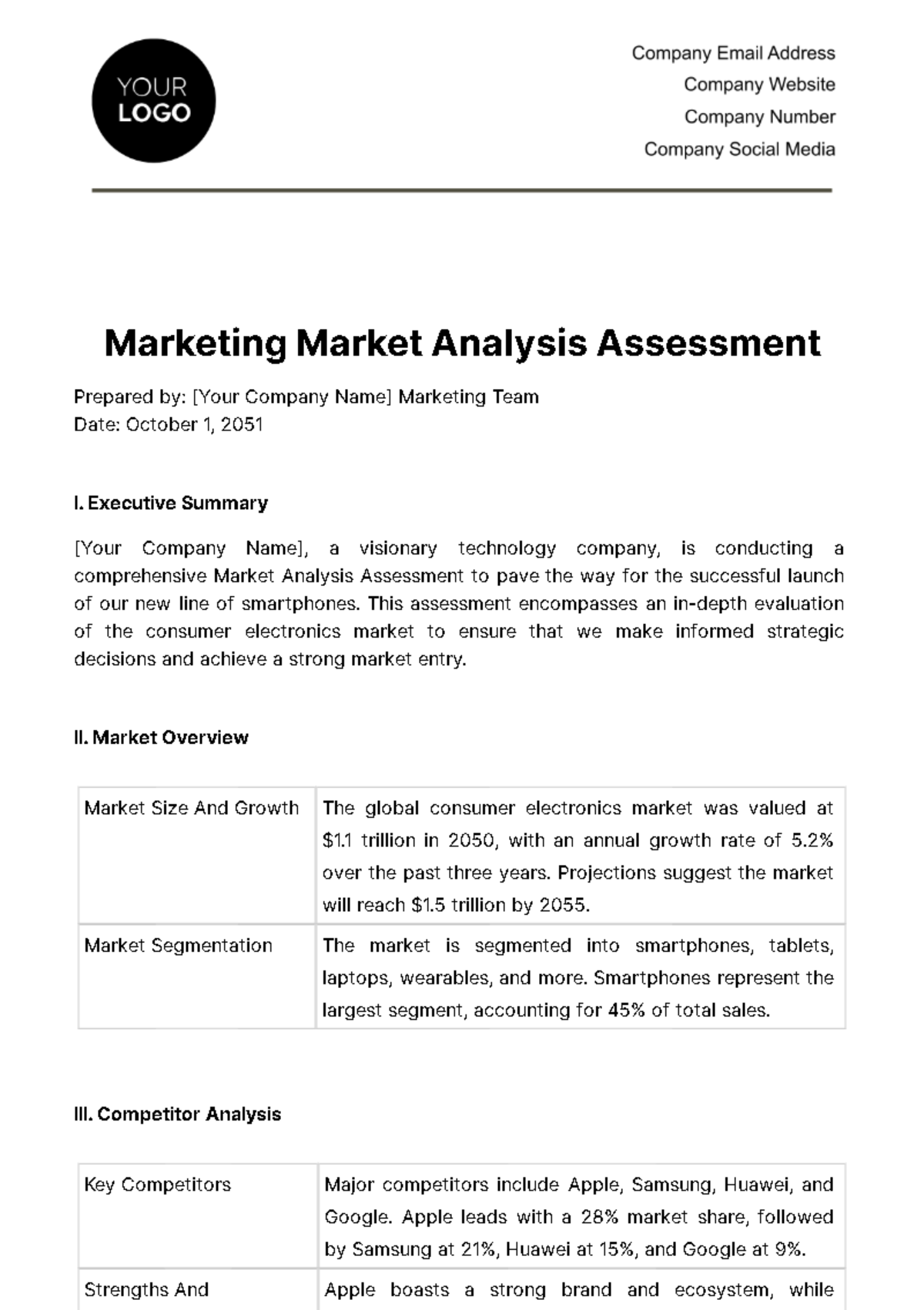Marketing Market Analysis Assessment
Prepared by: [Your Company Name] Marketing Team
Date: October 1, 2051
I. Executive Summary
[Your Company Name], a visionary technology company, is conducting a comprehensive Market Analysis Assessment to pave the way for the successful launch of our new line of smartphones. This assessment encompasses an in-depth evaluation of the consumer electronics market to ensure that we make informed strategic decisions and achieve a strong market entry.
II. Market Overview
Market Size And Growth | The global consumer electronics market was valued at $1.1 trillion in 2050, with an annual growth rate of 5.2% over the past three years. Projections suggest the market will reach $1.5 trillion by 2055. |
Market Segmentation | The market is segmented into smartphones, tablets, laptops, wearables, and more. Smartphones represent the largest segment, accounting for 45% of total sales. |
III. Competitor Analysis
Key Competitors | Major competitors include Apple, Samsung, Huawei, and Google. Apple leads with a 28% market share, followed by Samsung at 21%, Huawei at 15%, and Google at 9%. |
Strengths And Weaknesses | Apple boasts a strong brand and ecosystem, while Samsung offers diverse product offerings. Huawei faces political challenges, and Google is expanding its hardware presence. |
IV. Customer Analysis
Target Customer Profile | Our target customers are tech-savvy individuals aged 18-45, seeking high-quality smartphones with innovative features and competitive pricing. |
Customer Preferences | Surveys reveal that customers prioritize camera quality, battery life, and software updates when purchasing smartphones. |
V. Market Trends
Current Trends | Current trends include 5G adoption, foldable phone technology, and sustainability. Customers also prioritize privacy and data security. |
Emerging Trends | Emerging trends include augmented reality (AR) integration, sustainable materials, and increased focus on health-related features. |
VI. SWOT Analysis
VII. Market Barriers And Entry Points
VIII. Pricing Analysis
Competitive pricing will be crucial to gain market share. Pricing will be set competitively with premium and budget-friendly options to cater to different customer segments.
IX. Distribution Channels
Distribution will encompass both online and offline channels, including e-commerce platforms, flagship stores, and partnerships with mobile carriers.
X. Regulatory And Legal Factors
Compliance with global regulations related to data privacy and environmental sustainability will be a priority. A legal team will ensure all products meet industry standards.
XI. Market Forecast
Based on current growth rates and our market strategies, we project a 6% market share within the first two years and a 12% share within five years.
XII. Recommendations
Invest in a strong marketing campaign to build brand recognition.
Prioritize R&D for innovative features and sustainable materials.
Forge partnerships with app developers and content creators to enhance the user experience.
Develop a robust customer support infrastructure.
Continuously monitor market trends and adapt strategies accordingly.
XIII. Conclusion
[Your Company Name] is well-positioned to enter the competitive consumer electronics market with our innovative smartphone lineup. This Market Analysis Assessment provides a solid foundation for our marketing strategy, product development, and overall business decisions. With the right strategies and execution, we aim to become a significant player in the global smartphone market.
Marketing Template @ Template.net






























